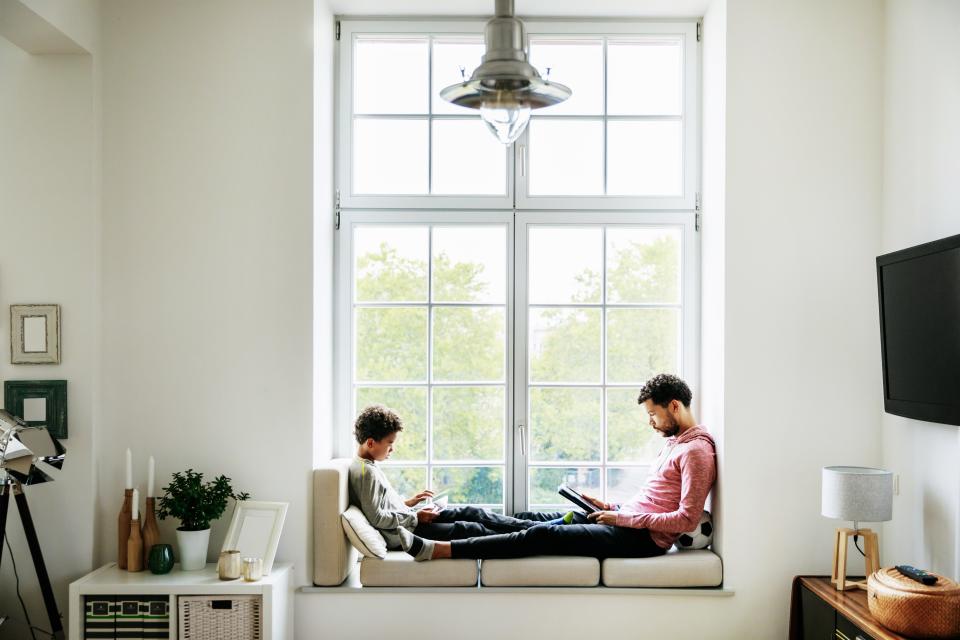’Tis the Season When Kids Want Tech Gifts. Here’s How to Feel Good About Saying Yes
It’s happening: My kids are getting their own Chromebook for the holidays. I know this may sound like a nonevent—plenty of parents I know (and admire!) long ago embraced giving kids their own devices, and plenty of the girls’ friends already have their own laptops, tablets, and smartphones. But our family has long stayed in a comfortable holding pattern closer to the other end of the tech spectrum: Our three kids, ages nine, seven, and four, use the family-room TV or a couple communal tablets (super outdated, rarely charged) on weekends. They also borrow my laptop, using it on the kitchen island where we can easily see what they’re up to. In other words, nobody’s had a personal device, and the hover-and-peek technique has been my main form of parental control.
This tech strategy—or lack thereof—has worked fine for a long time, but now we’re at a place where we would clearly all benefit from giving the older two kids more ownership of their tech. As they’ve grown, their screen time has become infinitely more nuanced than it was when they were little. There are so many productive activities they use screens for: printing coloring pages and worksheets they use to play school, doing homework and messaging their teachers in Google Classroom, streaming music during playdate dance sessions, practicing their math facts or music (Mom doesn’t know her way around a guitar or flute!), emailing or video-calling their grandparents, or clicking through our treasure trove of digital family photos/videos. I’ll even admit that the annoying YouTube channels I let them watch on weekend mornings have helped them learn some pretty awesome dance and gymnastic moves. Giving the girls access to these activities via their own computer would give me new ways to enforce time limits and monitor who’s doing what—beyond my usual hover-and-peek. Separate log-ins/desktops would keep their school websites and games organized, and I could curate what each kid can see. Plus, let’s be honest: I’m also just tired of getting my laptop back with a slightly sticky keyboard and 19 browser tabs open. (I do my work on this thing, people!)
“Navigating technology with our kids is definitely a challenge—we’re the first generation of parents whose kids were born into a smartphone-driven world. But I’ve come to the realization that as with so many things in life, moving forward is easier once you choose to focus on the positive rather than the negative.”
The Chromebook recently arrived, giving us time to tinker with it before holiday gift-wrapping time. I felt a little bit like I was cracking open a sleek metallic Pandora’s box. Let’s be honest: Part of my reluctance to give the kids their own devices was having to figure out what system I’d use to manage them. Obviously, I wasn’t going to just hand it over and give the kids free rein. And thinking ahead to a time when all three kids are using different devices in different places, keeping track of it all feels like such an uphill task—when they’re using devices, where, and for what purpose. Parental controls clearly help, but there are so many options, from software to whole-house devices to apps, each compatible with different devices. It’s enough to make an already overwhelmed mom’s head explode.

02 tech gifts
Tom Werner, Courtesy of Google.That’s why, before I set up the Chromebook, I started polling other parents on what’s worked best in their homes. I asked some friends with kids the same ages; turns out, they’re all just starting to figure this stuff out too. (Hover-and-peek is more popular than I thought!) I put a post on our always helpful local-moms Facebook group, anticipating dozens of comments right away. Instead, near radio silence. That’s when I realized that plenty of other parents feel just as overwhelmed by this new parenting frontier as I am—and don’t necessarily want to publicly admit that. Then I reached out to parenting/tech bloggers, who are more comfortable sharing a look into what happens in their households. Interestingly, despite their opposite philosophies about some things, like social media, they more or less share a core approach: Set up filtering/parental-control apps, devices or software as a safety net, but focus on teaching kids to make smart tech choices on their own so they don’t really need that net. Part of that is to find ways to shift more screen time toward the productive and educational stuff. Some snippets of what these moms shared with me:
“As the kids get older, we’ve been utilizing screen time more in some ways but less in others,” said Becky Mansfield of Your Modern Family, kids ages 7, 9, 11, and while she doesn’t allow her kids to download social media apps and blocks those websites too, she’s all about screen time that builds upon things they’re studying in school: “All kids learn in different ways, so finding a video, printable game, or online lesson that helps to expand on a concept is always a bonus.” She’s the holder of app-store password and the physical devices; the kids have to ask each time they use them.
“When my kids were younger, I was very concerned with the quality of content my kids they were consuming, but these days I’m more conscious about passive versus productive screen time,” shared Leticia Barr of Tech Savvy Mama, kids ages 13 and 16. “Sometimes they enjoy downtime by watching videos or texting friends, but other times they’re using screens to complete homework, learn new skills, or ask their classmates in a group text for help on a homework problem.” In addition to being proactive about asking her teens what they’re doing in their screen time, she uses Family Link, a free app, to see how many hours they’re devoting to different activities on their devices, as well as to help filter inappropriate content.
“We allow more time for certain educational apps than others and restrict the purely fun apps and games for the weekend,” said Marines Duarte of En Tus Zapatos, kids ages 5, 8, 9, and 17. She’s always trying different combinations of parental controls—devices, software, and apps—but only as a way to back up her strategy of empowering kids to make their own tech choices. “We all have to figure out ways to make technology as our friend instead of our enemy, so we try to motivate our kids to use it to learn or get motivated/inspired instead of just playing video games or using it as a distraction,” she said; for example, her older kids are allowed extra screen time to record and edit videos and produce music.

03 tech gifts
JGI/Jamie Grill, Courtesy of Google.Back in my own household, since we don’t plan on getting the girls phones any time soon, I decided to focus on what would work well for our current new Chromebook situation; we can always adjust the system as we go. (Baby steps!) I started by setting up Family Link, which was infinitely easier than I’d imagined. I created a log-in for each child on the Chromebook, using their Gmail accounts. Then I set up the following framework:
The girls can log on to the laptop only between the hours of 9 a.m. and 8 p.m. This way, when they get up before me on weekends, nobody is hopping on there without supervision. It will live in our downstairs office or on the kitchen counter and will not be allowed upstairs. (We intentionally picked a bigger, heftier model for this purpose.)
We approve every app they download, but opted not to approve every single website they visit. I tried doing that at first, and it was too tedious for us, especially considering that right now we’re not worried about them straying into dangerous territory; they’re using the laptop right under our noses in a very limited capacity. Family Link’s filter does attempt to block any inappropriate content, but of course no filter is perfect.
We blocked YouTube, which we want them using only with supervision. I prefer they watch it together on the smart TV when all can see, or I can unblock it for a period of time on the Chromebook.
Each child has one hour of screen time on weekdays for homework and educational games (the latter only once chores and homework and music practice are done). On Saturday and Sunday they get two hours of free computer time. One fun feature is that you can reward a child with bonus screen time (in 15-minute increments) with the click of a button in the app.
My husband and I keep tabs on everything—approve app downloads, see who’s logging on at what time and using which app, disable the laptop—via the Family Link app on our phones, or our computers by logging in to our account.
Setting all of this up took maybe half an hour (plus endless hours I then spent curating awesome educational apps on each kid’s desktop), and I feel infinitely more proactive and prepared. Turns out, I just needed some guard rails to help us venture into new technological territory as a family. Of course, the ultimate goal is for my kids to take the wheel. I can’t control what they access when they’re at friends' houses and as they get more independent. One resource we found helpful is Be Internet Awesome, which offers educational materials and fun “Interland” games to help kids build skills they need to be safer, smart, and positive online. First created for educators, it covers topics like: helping kids learn to communicate responsibly online and sharing what they can do in the event they come across something inappropriate; helping kids spot signs of phishing/scams; and guiding them toward being positive digital citizens. It’s been an amazing conversation starter.
Navigating technology with our kids is definitely a challenge—we’re the first generation of parents whose kids were born into a smartphone-driven world. But I’ve come to the realization that as with so many things in life, moving forward is easier once you choose to focus on the positive rather than the negative. I’m glad my kids will always be able to chat face-to-face with Grandma, get inspired by videos made by their favorite soccer stars, or seek online help when they’re struggling with math concepts Mom and Dad haven’t thought about since high school. I’m confident we’ll all continue to figure it all out—no matter what new device Santa delivers in the years to come.
Originally Appeared on Glamour

